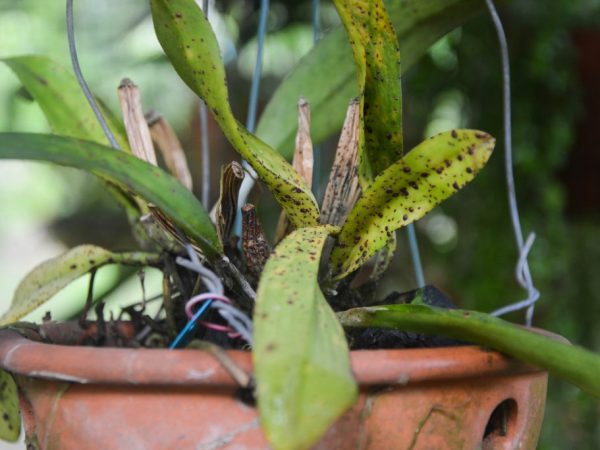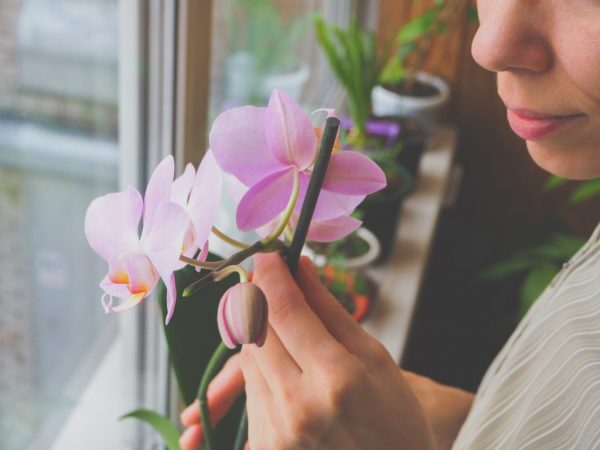How to get rid of spider mites and shell mites on orchids
Growing orchids at home brings a lot of positive emotions to its owner. This is a beautiful and sophisticated plant, pleasing to the eye with a color palette and a subtle, barely noticeable aroma. All is well until pests appear. A tick on orchids can kill a plant.

How to get rid of spider mites and shell mites on orchids
Description of pests
To learn how to help an orchid in pest control, it is worth knowing well the types of parasites. Applying the right actions and remedies saves the flower from death.
There are 2 types of pests that can start on phalaenopsis. The first is an armored mite, and the second is a spider mite or flat-bodied mite. Spider mites on an orchid pose a threat to the life of the flower, and shell mites harm indirectly, since they feed on the substrate.
Spiderweb
Spider mites are so small that it is difficult to replace how they appeared among the leaves. Adults are 0.1-0.3 mm long and appear microscopic. Among the features, white and gray, yellow with brown spots, or pure white are also distinguished.
The main habitat of pests is the reverse side of the leaf, on which it is easier for them to gain a foothold and not fall when watering. They lay eggs on green leaves, although they move throughout the plant. Laying is done along the veins on the sheet, from the inside. White paths are formed from the masonry. Spider mites crawl along the flower slowly, mostly spend their time immobilized.
The first sign of the appearance of ticks of this kind on the phalaenopsis is white dots and small cobwebs. A white bloom forms on the inside of the leaf. Often, an orchid becomes infected from other flowerpots or from a pest entering through a window. It multiplies rapidly, since the period of full development is 4 to 6 days.

Spider mites threaten the life of the flower, and shell mites feed on the substrate
Armored
Panzer mites on orchids are not uncommon, you need to fight them urgently: the bug quickly destroys the plant.
The body of the armored mite is colored red, brown, sometimes almost black. Its length is 0.7-0.9 mm. The pest moves quickly, does not like bright light. He runs all over the plant, but lays eggs on the dead parts of the orchid, rotten roots and branches.
Bugs give priority to wet, damp soil. They grow to full maturity over a period of 3-4 weeks to several months.
They do not eat the living tissue of flowers, but feed on the substrate, fallen leaves and petals.
The armored mite carries eggs of helminths and nematodes, fungus and bacteria.
Control methods
The approach to combating mite species is unique. The plant will have to be treated not only for pests, but also for the ailments that they carry: bacteria, fungi.
Spider mite control
To get rid of a spider mite on an orchid, a flower pot is taken out to a balcony or loggia: you need good access to fresh air.The stem, foliage and buds are treated with an acaricidal or insectoacaricidal agent from a spray bottle. To enhance the action of the solution, the stem with leaves is wrapped in a bag for several days, reducing the supply of oxygen to the insects. It is impossible to overheat the pot: this is fraught with the appearance of root rot.
Control measures also include getting rid of the larvae. The drug for adults does not harm eggs and newly hatched individuals, so the control procedure is repeated at least 3 times with an interval of 4–5 days. Next, the orchid is treated with a fungicidal solution in case the pest has managed to infect the plant with a fungus.

Methods of dealing with different types of ticks
Fighting the shell mite
To cure a flower from a mite, the first step is to remove the old substrate: the root mite on the orchid lives there. Then the roots of the orchid are cleaned of the remaining mites. With the help of chemicals, the roots, stem and leaves are treated by soaking them in a solution of acaricide. To remove a mite on a blooming orchid, use:
- Fitoverm;
- Nisoran;
- Vermitic.
After that, a fresh substrate is poured and the flower is transplanted.
The application procedure is repeated after 2 weeks, alternating preparations: this way the tick does not have time to adapt. When replacing the substrate, treatment with antifungal agents is not required.
Prevention
You can not be afraid of pests on phalaenopsis if you take preventive measures.
To prevent the appearance of a shell mite, the soil in the pot is periodically dried: the pest prefers a moist, damp substrate.

Preventive measures against pests
When spraying orchids, they monitor the amount of moisture that has got on the leaves. Excess water collected between the stem and leaves in the axils is wiped off with paper towels or cotton pads. By controlling the moisture content of the substrate within the optimal norm, the presence of root rot is excluded, and the armored mite on the orchid feeds on the dead plant particles. Keeping the pot clean, removing fallen leaves and petals in time, excludes the possibility of the appearance of oribatids.
A spider mite on an orchid, in contrast to a shell mite, prefers warm places with low humidity. In apartments with centralized heating, the air is often overdried to a level of 35-40%, which increases the risk of a pest.
Be sure to monitor the degree of moisture in the substrate, develop a schedule for watering and spraying. One of the simplest preventive measures is to wet the petals and stem of the orchid.
Conclusion
No one gives guarantees that the orchid will never encounter pests at home, but the treatment started on time easily removes the pest. To avoid problems, they use preventive safety measures, observe all care regimes, and control the microclimate in the room. As a result, there is no need to be afraid of the appearance of a red shell mite on orchids.


